Veggies and vegans are in for a treat – Prudence Wade finds out more.
When Rukmini Iyer moved back in with her parents during the first lockdown of 2020, she accidentally found herself with the most honest recipe testers she could have hoped for. “My mum doesn’t really hold back on constructive criticism,” the food writer and cook admits. “I think her words are, ‘If I don’t tell you, then who will?’”
But that honesty came in useful, with Iyer saying it was “really helpful to get her feedback” – particularly as she used the time to write her latest cookbook dedicated to veggie and vegan barbecue recipes.
Both Iyer’s parents are GPs – her mother is now retired, but her father was still working. “So dad was at the surgery, but he likes to pop back for lunch because it’s not too far – so I tried to have things rolling off the barbecue in time for him to have a quick lunch before he went back to the surgery,” she says.
“It was very nice because as an adult, you don’t spend that much time with your parents. It was lovely to have them around and be able to cook a book where they could eat everything” – both her parents are vegetarian.
As well as being a way to bond with her family, Iyer fell in love with the therapeutic elements of barbecuing. “It was probably just being outside a lot,” she confesses. “I wrote the book during the first lockdown – I was in my parents’ garden and I didn’t want to spend any time indoors, because it felt strange to be in that lockdown situation.
“I was even doing all the prep outside. I was taking a chopping board, all my veg, a couple of little bowls, doing all the prep outside and sitting and waiting for the barbecue to light. It was maximising being in open space.”
She also found it a “more mindful way to cook”, while still sharing some similarities with her smash hit Roasting Tin series of books which all focus on easy, one pan meals you bung in the oven.
“With this one, it’s similar in you just have to chop some things, put them on the barbecue, take them off and put a nice dressing on,” she says.
“But you’ve got that added element I think is interesting, where you have to be quite watchful. You learn to understand how your barbecue is working. You think about when it’s hot, when it’s not. You’re standing in front of it and it’s a visual and very tactile way to cook – I like that added element that you’re very close to the cooking process.”
There was another added benefit to decamping to her parents’ house: space. “Having an outdoor space – I live in London in a flat, so usually I’m not really able to,” Iyer says. “But even though I was doing all the barbecuing in my parents’ garden, I was very much thinking, ‘What’s portable? What can I do on a small barbecue?’
“You can’t assume everyone’s got a massive Weber range – you might just be using a small one you got from TK Maxx. So at some points when I was testing I had about three barbecues on the go: I had a big TK Maxx bucket, a little Heston Blumenthal grill, a nice tabletop little Prakti stove – trying to think about the ways in which people who maybe don’t always have access to outdoor space can still make something really nice.”
If you’re barbecuing in the park and can’t whip in and out of the kitchen, Iyer’s top piece of advice is “you don’t have to barbecue everything – you can take loads of things with you, and maybe barbecue one or two little elements”.
As the weather starts to brighten, many of us will be looking to fire up our barbecues as an easy way to see friends and family outdoors. Iyer’s book offers an alternative to the meat fiestas we’re used to, and she hopes it will encourage barbecue novices to give green dishes a go.
“What’s the worst that could happen?” asks Iyer, adding a safety disclaimer that you should be extremely careful with fire. “Get a feel for how hot it is – I think that’s the key takeaway. You can put almost anything on a barbecue, but to coax maximum flavour from it, you want to make sure you’re watching it like a hawk.
“If it’s too hot and things are getting too burnt, just take them off, let it cool down, and put them back on. It’s sort of slowing down, this kind of cooking” – exactly the kind we need, particularly if you’re suffering from re-entry anxiety as lockdown eases.
Iyer loves how barbecuing is “big, generous platters of food” to share with your loved ones. With a background in food styling, she knows how to make dishes look beautiful – and al fresco dining isn’t about “little primped plates of food”.
She says: “The nice thing about a barbecue is you’ve got lots of platters of food, things coming off the barbecue at different times. If you throw over some herbs, make a nice dressing, toast some nuts – I would describe it as Ottolenghi-style sharing platters, which is easy to make look beautiful.
“It looks generous, because it is.”
Words by Prudence Wade, PA
Pictures credit David Loftus/PA
Crispy gnocchi with charred peppers and basil pesto, serves 3-4
INGREDIENTS
- 1 x 500g packet of gnocchi
- 3 mixed peppers, chopped into gnocchi-size pieces (don’t use green peppers)
- 2 tablespoons vegan basil pesto
- 3 tablespoons olive oil, plus more for brushing
- A pinch of sea salt flakes
- A good amount of freshly ground black peppercorns
- 8–12 skewers, soaked if wooden
For the dressing:
- ½ lemon, juice only
- 4 tablespoons vegan basil pesto
- 2 tablespoons extra virgin olive oil
- A pinch of sea salt flakes
METHOD
- Tip the gnocchi into a bowl of just-boiled water, and leave to blanch for two minutes, then drain and run under cold water to cool.
- Put the gnocchi into a large bowl with the chopped peppers, vegan pesto, olive oil, sea salt flakes and freshly ground black peppercorns, and mix well to coat. At this point you could refrigerate the gnocchi until you’re ready to barbecue.
- Thread the gnocchi and pepper alternately onto the skewers. Once your barbecue is good and hot, brush one side of the skewers with oil, then lay them over the barbecue at a slight angle (this stops them falling through) and cook for four to five minutes, until the gnocchi are crisp and brown. Brush the tops with oil, then turn over and repeat with the other side.
- Meanwhile, mix the lemon juice, pesto and extra virgin olive oil with a pinch of sea salt flakes to taste. Once the skewers are cooked through, serve immediately, with the basil dressing alongside.
Squash with charred carrots, red onions, coriander seeds, pistachios and lime, serves 4
INGREDIENTS
- 600g squash, cut into 2½ cm slices (no need to peel)
- 150g baby carrots, whole and unpeeled (or 3 medium carrots, peeled and halved)
- 1 red onion, quartered, core intact
- 2 teaspoons olive oil
- 1 teaspoon coriander seeds, crushed
- 1 teaspoon ground cumin
- 1 teaspoon sea salt flakes
- 50g pistachios, roughly chopped
For the dressing:
- 2 tablespoons extra virgin olive oil
- 1 lime, zest and juice
- 2 teaspoons coriander seeds, crushed
- ½ teaspoon black peppercorns, crushed
- 1 teaspoon sea salt flakes
METHOD
- Tip the squash, carrots and red onion into a large bowl, and mix with the oil, spices and sea salt flakes.
- In a separate bowl, mix the extra virgin olive oil, lime zest and juice, coriander seeds, crushed black pepper and sea salt flakes. Taste and adjust the salt as needed, and
set aside. - Once your barbecue is ready, lay the squash slices on the grill, and cook for 25 minutes on each side, covered if you can. The carrots and the onions should only take about 15 minutes per side, so pop them on 10 minutes after the squash and take them off 10 minutes before the squash.
- Once the vegetables are all cooked through, transfer them to a platter and gently
mix with the lime and coriander-seed dressing. Scatter with the pistachios, and serve hot or warm.
Aubergine and goat’s cheese burger stacks, serves 2
INGREDIENTS
- 2 large, evenly sized aubergines
- 2 x 100g rind-on goat’s cheese wheels
- A handful of fresh lemon thyme sprigs
- Olive oil, for brushing
- Sea salt flakes
- Freshly ground black pepper
- Runny honey
- Crusty bread rolls, to serve
METHOD
- Cut the aubergines into 1cm slices, and the goat’s cheese into very thin rounds. Sandwich each piece of goat’s cheese between two similarly sized slices of aubergine, along with a sprig of thyme. Brush both sides of the aubergine with oil and add a tiny pinch of sea salt flakes and black pepper.
- Once your barbecue is ready, place the aubergine stacks on the grill and cook for 10–15 minutes per side, until the aubergine is cooked through and the cheese has melted. You can flip them every five to six minutes or so and give them a brush with olive oil.
- Transfer to a serving platter, drizzle with honey, scatter over the remaining thyme, and serve with crusty rolls on the side.
The Green Barbecue: Vegan & Vegetarian Recipes To Cook Outdoors & In by Rukmini Iyer, photography by David Loftus, is published by Square Peg, priced £17.99. Available now.
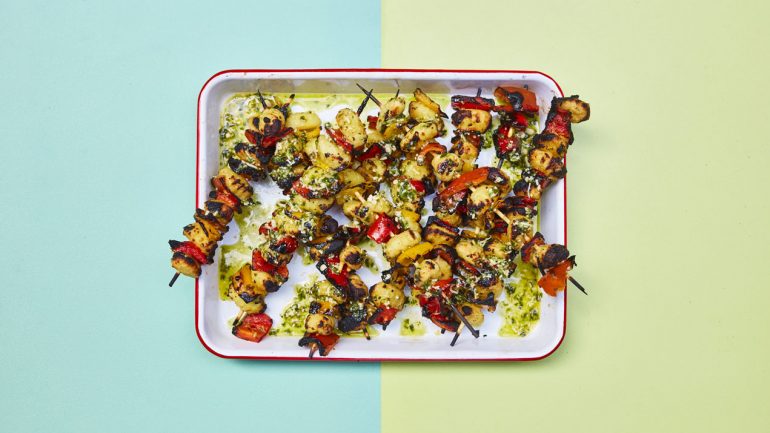
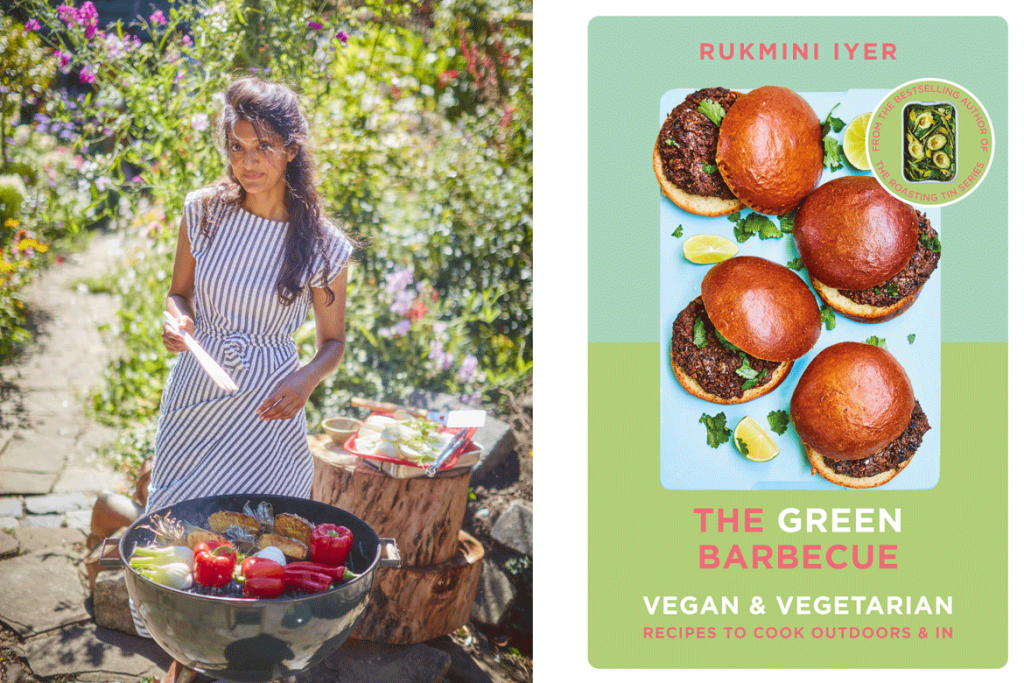
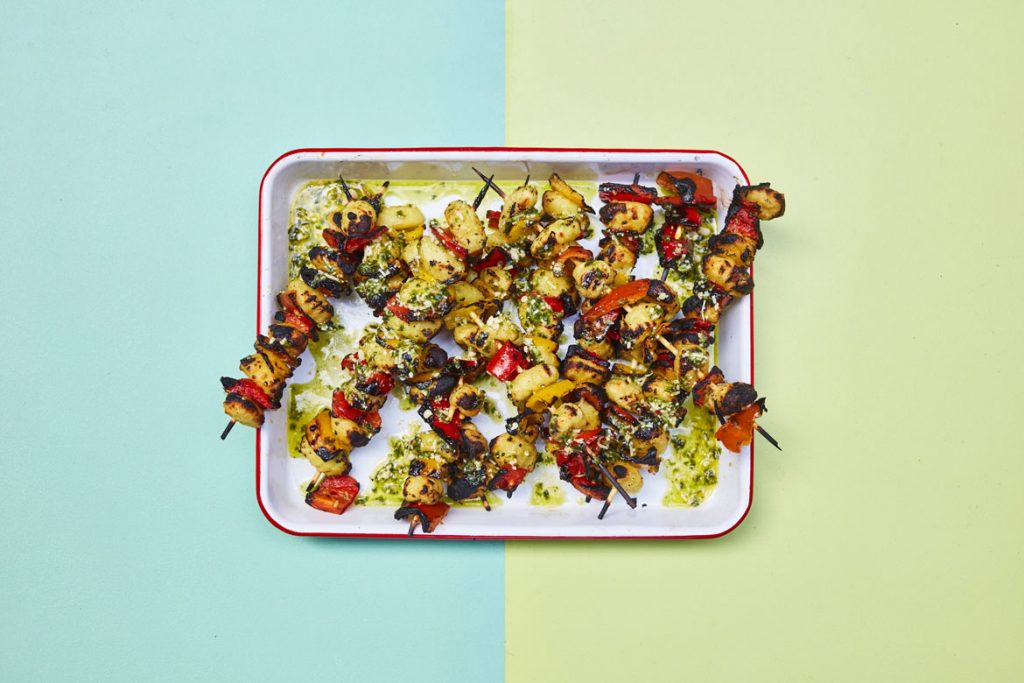
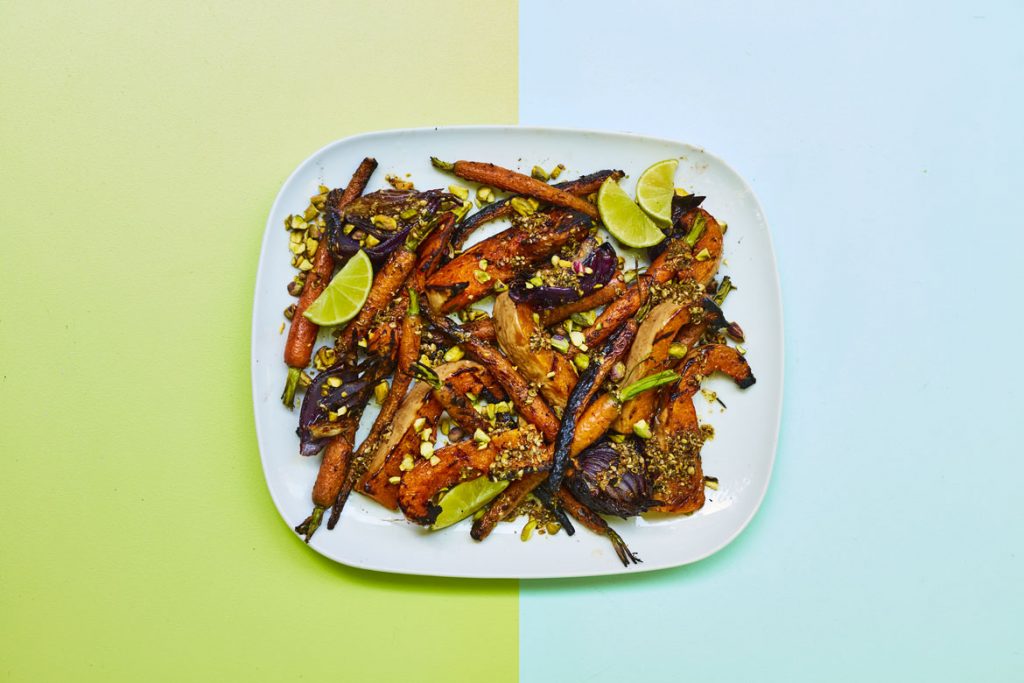
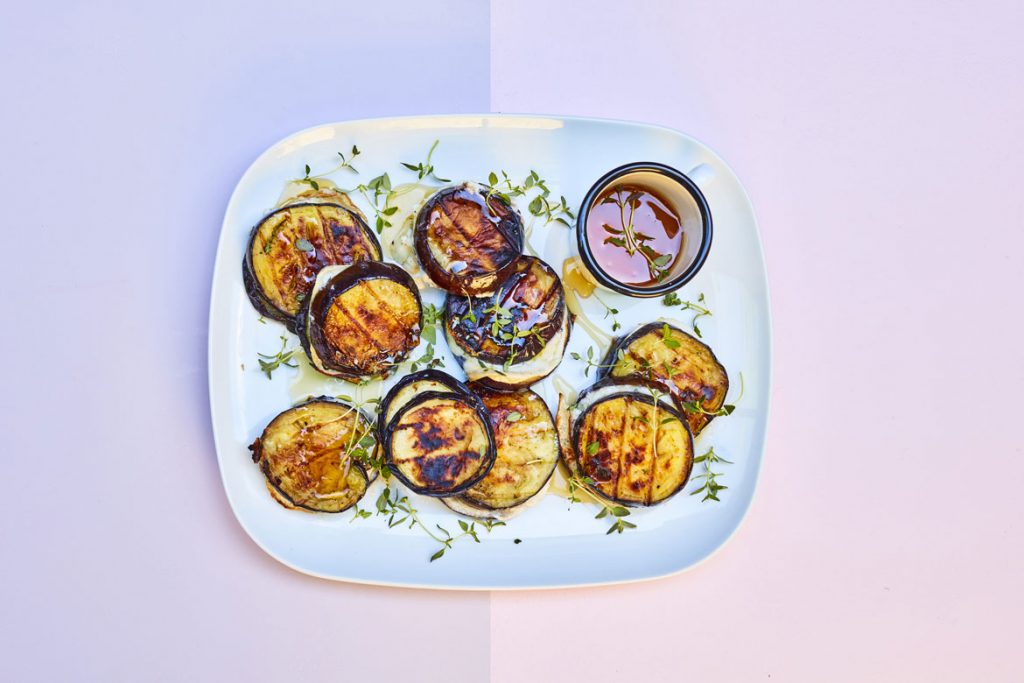

Leave a Reply